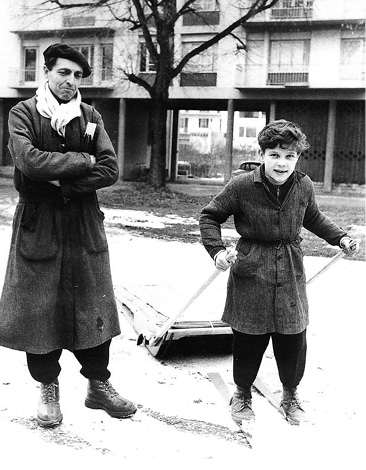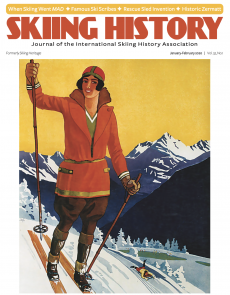
SKIING HISTORY
Editor Kathleen James
Art Director Edna Baker
Contributing Editor Greg Ditrinco
ISHA Website Editor Seth Masia
Editorial Board
John Fry, Seth Masia, John Allen, John Caldwell, Jeremy Davis, Kirby Gilbert, Paul Hooge, Jeff Leich, Bob Soden, Ingrid Wicken
Founding Editors
Morten Lund, Glenn Parkinson
To preserve skiing history and to increase awareness of the sport’s heritage
ISHA Founder
Mason Beekley, 1927–2001
ISHA Board of Directors
John Fry, Chairman
Seth Masia, President
Wini Jones, Vice President
Jeff Blumenfeld, Vice President
John McMurtry, Vice President
Chan Morgan, Treasurer
Einar Sunde, Secretary
Richard Allen, Skip Beitzel, Michael Calderone, Christin Cooper, Art Currier, Dick Cutler, Chris Diamond, Mike Hundert, David Ingemie, Rick Moulton, Wilbur Rice, Charles Sanders, Bob Soden (Canada), Betty Tung
Presidential Circle
Christin Cooper, Billy Kidd, Jean-Claude Killy, Bode Miller, Doug Pfeiffer, Penny Pitou, Nancy Greene Raine
Business & Events Manager
Kathe Dillmann
P.O. Box 1064
Manchester Center VT 05255
(802) 362-1667
kathe@skiinghistory.org
Membership Services
Laurie Glover
(802) 375-1105
laurie@skiinghistory.org
Corporate Sponsorships
Peter Kirkpatrick
(541) 944-3095
peterk10950@gmail.com
Skiing History (USPS No. 16-201, ISSN: 23293659) is published bimonthly by the International Skiing History Association, P.O. Box 1064, Manchester Center, VT 05255.
Periodicals postage paid at Manchester Center, VT and at additional mailing offices. Postmaster: Send address changes to ISHA, P.O. Box 1064, Manchester Center, VT 05255
ISHA is a 501(c)(3) public charity. EIN: 06-1347398
Written permission from the editor is required to reproduce, in any manner, the contents of Skiing History or skiinghistory.org, either in full or in part.
The Braked Rescue Sled
Seven decades ago, Roger Sylvand and Emile Allais invented a safer new way to get injured skiers off the mountain.
By Thomas Sylvand
During the summer of 2019, Bonneville, the ski-resort town in the French Alps, lost a landmark. The factory Traineau Sylvand (Sylvand Sleds) was torn down to make way for real estate development.
For six decades, beginning in 1947, that factory produced rescue sleds (traineaux de secours) for ski patrols across France and around the world. The inventor of that sled was my grandfather, Roger Sylvand. He created the prototype at the request of Emile Allais, the world champion skier who was the guiding light for French ski resort development in the post-war years.
The Sylvand family has lived in the high mountains for many generations. My great-grandfather Louis, wounded in World War I, moved his young family to Praz-sur-Arly, just outside Megève, in 1922, when Roger was 11 years old.
As my father, François, tells the story, Roger was greatly impressed by Robert Flaherty’s classic documentary Nanook of the North, and especially fascinated with the dogsleds. He built his own sled, from barrel staves, and tested it with his infant brother André as passenger. Naturally, the sled came to pieces on a curbstone. Fortunately, André was wrapped in layers and layers of swaddling, and came to no harm. Roger suffered a severe scolding.
The family lived in a hillside cottage. Like the neighbors, in winter they hauled groceries and firewood on sleds and sledges, and throughout the 1920s witnessed the rapid growth of alpine skiing (Megève was the first of the French lift-served resorts). As a teenager, Roger helped to set up the first ski-tows, on land owned by cousins, and drove buses hauling skiers uphill. He became an inventive mechanic, rigging up a rack-and-pinion system to simultaneously operate all the window-shutters on one side of the cottage. In the years leading up to World War II, he served in the mountain artillery and was tasked with devising over-the-snow transport solutions. He got to build more sleds.
Hilaire Evrard, a maternal uncle, owned a hardware store in Megève and an up-to-date factory in Bonneville that produced steel cable and elevator machinery, plus skis sold under the Brévent, Buet and La Para brands, and the Swiss-designed “Luge de Megève.” Evrard died suddenly in 1946. The family split up the businesses—the Evrards took over the hardware store and Roger Sylvand managed the factory, gradually buying ownership. He dropped the cable and elevator operations to focus on wood products: skis and sleds.
Roger set to work modernizing the carpentry operations. After a loose router bit nearly killed him, he focused on safety issues, ventilating sawdust to the basement to reduce fire hazard, installing an elaborate fire-alarm system he designed himself, and even setting up a system to stop the machinery automatically whenever a stranger came through the door.
It was an era of rapid innovation in ski resort management. Emile Allais returned from the Americas, where he had designed new trail systems and set up new ski schools. He brought with him Howard Head’s new metal skis, and a lot of great ideas about mechanical slope grooming and ski patrol operations.
In consultation with Allais, in 1947 Roger Sylvand came up with a great improvement for ski patrol rescue sleds—a simple and robust braking system that would allow a single patroller to bring the sled down safely on most pistes. Very simply, he put the meter-long steering handles on hinges, and when the steering skier pressed the handles down, they levered a pair of steel claws into the snow (or ice), slowing the rig efficiently. The claws were spring-loaded so as to retract when pressure was released on the handles. He applied for a patent in 1950, and it was granted in 1952. Allais helped to sell the system to other European ski patrols. In 1954, Allais demonstrated the new sled at a convention in Davos, and it won a gold medal.
Photo top of page: Roger Sylvand encourages his son François to demonstrate how little muscle it took to operate the rescue-sled prototype.
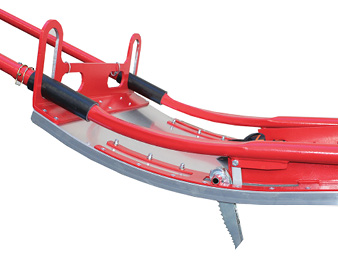
The sled, made of hardwood, aluminum and steel, with a thin canvas-covered mattress, was light and tough enough to be handled by one “pisteur” in most skiable terrain. It sold well, and kept the factory operating long after wooden skis and luges went defunct.
Even after retiring, my grandfather kept a close eye on the factory until his death in 1995, and it continued to produce sleds until closing in 2008. Recently the village of Praz-sur-Arly opened a new medical clinic, Chalet Sylvand, named in his honor.
ISHA president Seth Masia translated this story from its original French version and added editorial notes and clarifications.
A Short History of Rescue Sleds
The first patent for a sled with a braking system was issued in 1869 to Constantine de Bodisco, of St. Petersburg, Russia, who created a heavy iron contraption for coasting down icy hillsides. A spring-loaded steel plunger was mounted on the steel runners on either side. A rider would press down on the knob at the top of the plunger to engage the bottom end into the ice. Thus could a gentleman calm the nerves of his lady passenger.
The need for rescue sleds became evident during World War I, especially for use in the bloody alpine battles between Italy and Austria. Beginning in 1914, dozens of patents were issued for devices to mount a canvas stretcher onto a pair of skis, presumably the skis belonging to the evacuee. The inventors were Swiss, Austrian, Canadian, Norwegian, American and French. None of these systems addressed braking. On a schuss, ski-borne operators had to control speed by wedging or side-slipping. As alpine skiing developed in North America during the 1930s, early ski patrollers rigged toboggans with a variety of steering-handles and dragging-chain braking systems.
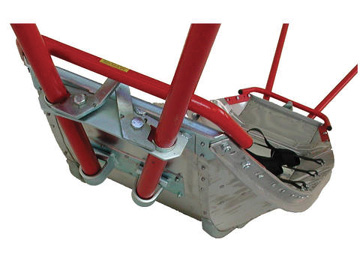
Also during the 1930s, Finnish skiers used newly available aluminum sheeting to bang together a lightweight trough-shaped sled they called an akja. It was designed to float boat-like in deep snow, and with steel runners it could be safely handled on ice. With a skier at each end, it could haul munitions cross-country, and was so used during the Winter War with Russia in 1938. The German Army took note and stamped out akjas for its own mountain troops, going so far as to mount machine guns on some. Thus came the akja to Austria, where it is still manufactured, thousands per year, for ski patrols around the world. Austrian mountaineer Kurt Beam, who emigrated to Seattle in 1941 and became a fixture in ski patrolling, introduced the akja to North America in time for the 1960 Squaw Valley Olympics.
In 1940, soldiers of the nascent 10th Mountain Division came up with their own rescue-and-cargo toboggans. Lieutenant Colonel Avery Cochran, who had begun working with dogsleds in Alaska in 1939, in 1943 was issued a patent on behalf of the 10th’s Mountain’s rescue sled—a toboggan equipped with a light steel framework at each end, attached via quick-linking rods to belts worn by skiers in front and in back. Thus the troopers had their arms free for the use of poles in cross-country skiing.
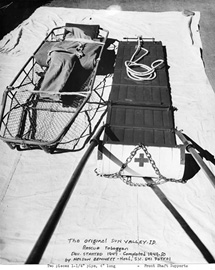
Then, in 1946, 10th Mountain veteran Nelson Bennett returned to his job as ski patrol director at Sun Valley and began working on his own sled design. Introduced in 1948, the Bennett sled used a wooden toboggan stabilized with a couple of steel skegs at the back corners, a detachable wire-mesh Stokes litter, and folding or removable steering steering arms. Braking was aided by a drag chain under the nose of the sled, controlled by the pilot with a rope. Not only could it be piloted by a single patroller, it could be uploaded on a single chair by the same patroller. It became a standard item of equipment at North American resorts. —Seth Masia
Table of Contents
2020 Corporate Sponsors
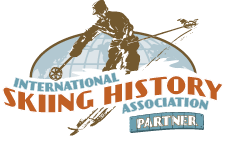
World Championship
($3,000 and up)
Alyeska Resort
Gorsuch
Intuition Sports, Inc.
Obermeyer
Polartec
Warren and Laurie Miller
Snowsports Merchandising Corporation
World Cup ($1,000)
Active Interest Media | SKI & Skiing
Aspen Skiing Company
BEWI Productions
Bogner
Boyne Resorts
Country Ski & Sport
Dale of Norway
Darn Tough Vermont
Descente North America
Dynastar | Lange | Look
Fairbank Group: Bromley, Cranmore, Jiminy Peak
Fera International
Gordini USA Inc. | Kombi LTD
HEAD Wintersports
Hickory & Tweed Ski Shop
Mammoth Mountain
Marker-Völkl USA
National Ski Areas Association (NSAA)
Outdoor Retailer
POWDR Adventure Lifestyle Corp.
Rossignol
Ski Area Management
Sun Valley Resort
Vintage Ski World
World Cup Supply, Inc.
Gold ($700)
Race Place | BEAST Tuning Tools
The Ski Company (Rochester, NY)
Thule
Silver ($500)
Alta Ski Area
Clic Goggles
Dalbello Sports
Deer Valley
Ecosign Mountain Resort Planners
Hertel Ski Wax
Holiday Valley
Hotronic USA, Inc. | Wintersteiger
MasterFit Enterprises
Metropolitan New York Ski Council
Mt. Bachelor
NILS, Inc.
Portland Woolen Mills
Russell Mace Vacation Homes
Schoeller Textile USA
Scott Sports
Seirus Innovations
SeniorsSkiing.com
Ski Utah
Snow Time, Inc.
Sports Specialists, LTD
SympaTex
Tecnica Group USA
Timberline Lodge & Ski Area
Trapp Family Lodge
Vuarnet
Western Winter Sports Reps Association
For information, contact: Peter Kirkpatrick | 541.944.3095 | peterk10950@gmail.com
ISHA deeply appreciates your generous support!

